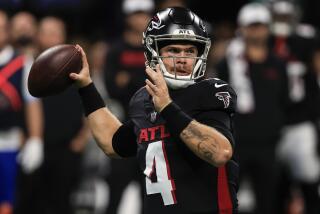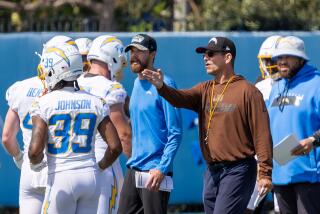Technology, younger GMs have led to more active NFL trade market before free agency starts
In the NFL, the warmup band has upstaged the main act.
The party hasnât officially started, and already the ground is covered with confetti.
What is typically a landmark day â the beginning of the league year Wednesday and start of free agency â is little more than a formality now, a mild aftershock.
Consider all that has happened in the last two weeks, with Kansas City trading quarterback Alex Smith, Seattle trading defensive end Michael Bennett and cutting iconic cornerback Richard Sherman, Cleveland trading for quarterback Tyrod Taylor and receiver Jarvis Landry, the Rams turning their secondary into a primary with the addition of playmaking cornerbacks Marcus Peters and Aqib Talib before trading middle linebacker and defensive captain Alec Ogletree.
Those trades wonât be official until the start of the league year, but nobody crowds around to watch newlyweds sign their marriage license.
Although the official start to free agency isnât until 1 p.m. PDT on Wednesday, clubs can begin negotiating with free agents Monday. That means by Tuesday night, teams have their wallets out and are waiting in line at the register.
There are still some big-name free agents in the mix, quarterbacks Kirk Cousins and Drew Brees (still a longshot to leave New Orleans) among them. But much of the drama already has taken place.
Several factors help explain the uptick in trade activity in recent years, one that reached a fever pitch in February and early March. Most of the old-guard general managers are gone and the business is dominated by younger, often more aggressive executives who are more willing to make bold moves to change the course of an organization. And then there are the enhanced methods of communication.
âThe ability to text is huge,â said Rams GM Les Snead, 47. âYouâre not ever really going to group text, but you can shoot off a proposal, an idea, to 10 or 15 general managers in less than two minutes. In the days when you had to call, and letâs just say the other person says, âOK, Iâll get back to you.â And then when you make your second call, here comes the GM you called first. Now, youâre playing phone tag.
âCommunicating with 31 other GMs would take 10 minutes these days, whereas I donât even know if you could have gotten that done in three days before texting.â
Most of the GMs came up through the scouting ranks, and spent more time on the road with their colleagues than they spent with their families.
âIt starts first with relationships, and that probably hasnât changed since scouting started,â said Chargers GM Tom Telesco, 45. âIf you came up in the business on the college scouting side, you formed a lot of relationships with college scouts when youâre on the road and traveled school to school. As you come up through the business, a lot of those guys have become GMs.
âIf you came up on the pro side, when youâre at an NFL game, advance scouting, you sit right next to the other teamâs pro scout. So in both those instances, thatâs where those personal relationships start. But when you add in the ability to email, call, text another GM at any time or in any place, that enhances it.â
Earlier this week, Telesco was in trade talks with another GM while the Chargers executive was in a free-agency meeting during the day.
âIt was actually very efficient, because I was doing two things at the same time,â Telesco said. âBefore, youâd have to get up, leave, shut the door, make a phone call, then go back to the meeting.â
The trade never came to fruition, and Telesco declined to share the details of what might have transpired. But itâs the new way of doing business in a league so entrenched in tradition.
There are lots of free-agent deals that will be done in the coming weeks, most involving players who are more solid than spectacular. The main spotlight will be trained on Cousins, who appears to have narrowed his choices to Minnesota, Denver, the New York Jets and Arizona. Oddsmaker Bovada.LV has the Vikings as the 1-3 favorite to land him, followed by the Broncos (10-3), Jets (5-1), and Cardinals (15-1).
The Vikings have done their part, clearing the deck at the position with the release of Case Keenum, Sam Bradford and Teddy Bridgewater. That infusion will give other quarterback-needy teams options besides delving into this draft class, which includes talented quarterbacks such as USCâs Sam Darnold, Wyomingâs Josh Allen, UCLAâs Josh Rosen, Oklahomaâs Baker Mayfield and Louisvilleâs Lamar Jackson.
The situation with Brees is a little different. His contract doesnât void until Wednesday, so he isnât eligible to talk to teams during the two-day negotiation period at the start of the week. While itâs difficult imagining him leaving New Orleans, where heâs the face of the franchise, itâs possible that someone could lure him away with a Brinks truck full of money.
As for Sherman, he confirmed to The Times that he agreed to a deal Saturday with the San Francisco 49ers, reportedly for up to $39 million.
âIâm excited. Back in the Bay,â said Sherman, who played at Stanford.
Sherman will be 30 years old going into next season and is coming off an Achilles injury that cost him half of the 2017 season.
This much is clear: Thereâs more maneuvering to come, and deals will be done between new-age and old-school executives.
An example of that came with the trade of the Ramsâ Ogletree to the New York Giants, where Snead handled much of his communications electronically with Dave Gettleman, the 67-year-old Giants GM.
But the deal was sealed with a phone call from Snead.
That ended, appropriately, with Gettleman telling him: âNice doing business with you, kiddo.â
Follow Sam Farmer on Twitter @LATimesfarmer
More to Read
Go beyond the scoreboard
Get the latest on L.A.'s teams in the daily Sports Report newsletter.
You may occasionally receive promotional content from the Los Angeles Times.











